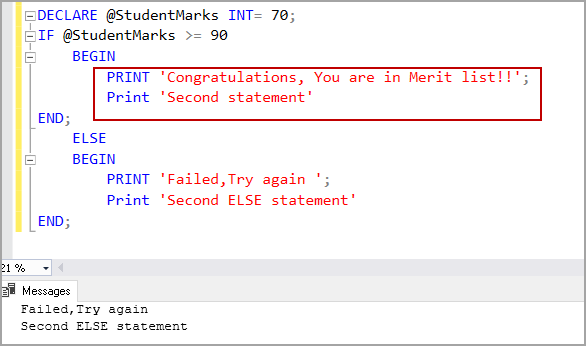
The complete text of a function definition must be a block. How do you do a simple begin - end statement block inside of a psql session? For Example , I want to.
My goal is to test the count of a table and do such and such from there. Do I have to make this a function? This keyword may optionally be followed by either of the noise terms WORK or TRANSACTION, though they have no effect on the statement, or the transaction block. Transaction blocks are explicitly started with the BEGIN SQL command. Example 7-begins a transaction block within the booktown database.
The solution is to use exception clause in the function. BEGIN initiates a transaction block, that is, all statements after a BEGIN command will be executed in a single transaction until an explicit COMMIT or ROLLBACK is given. A transaction is a unit of work that is performed against a database. It starts no new (sub)transaction as nested transactions are not implemented in PostgreSQL. You can set the variable to a value in line using like this DECLARE _accountid INT.
Hi, I am quite new to postgresql and working with application team to migrate to postgresql from oracle. When we are trying to use bind variable within. Although all Transact-SQL statements are valid within a BEGIN. In the following example , BEGIN and END define a series of Transact-SQL statements that execute together.
However, a block containing an EXCEPTION clause effectively forms a subtransaction that can be rolled back without affecting the outer transaction. END block were not include both. Stack Exchange network consists of 1QA communities including Stack Overflow, the largest, most trusted online community for developers to learn, share their knowledge, and build their careers. There are two forms of the CASE statement: simple and searched CASE statements.
Notice that you should not confuse about the CASE. Control from this section can never return to the execution block. Then there is a BEGIN END structure that defines the meat of the function. PostgreSQL whether SQL, PLPGSQL or some other language can use recursion.
The END keyword designates the end of the code block. Example Function: CREATE OR REPLACE FUNCTION CREATEPLANET(planet VARCHAR(50), galaxy VARCHAR(40), numofmoons INT, wt FLOAT) RETURNS void AS $$ BEGIN INSERT INTO PLANET VALUES. After the final commit at the end of the transaction, the only row inserted is the first one from the beginning of the transaction. Since the anonymous block is an autonomous transaction, the rollback within the enclosed procedure has no effect on the insertion that occurs before the anonymous block is executed.

The COMMIT, ROLLBACK and SAVEPOINT are very common for all RDBMS. We should use $$ - Double Dollar to avoid all quoting issues of a function. SQL is a language where one task can be solved multiple ways with different efficiency.
In this example, you just use the execution part to execute code. You will learn how to declare variables and handle exceptions in the next tutorials. Exercise on anonymous block structure. In this article, I will try to explain about the advanced database language, which is PL SQL. The below approach explains how a function can be declared in an anonymous block without creating them permanently in the database.
The declaration of the function should be always at the end of the declare section of an anonymous block after all the necessary declarations of the anonymous block are declared. SAVEPOINT: SAVEPOINT command save the current point with the unique name in the processing of a transaction. AUTOCOMMIT: Set AUTOCOMMIT ON to execute COMMIT Statement automatically. This is one of the frequent task a DBA get in routine tasks.
Schema refresh is nothing but copying the schema from one database to another database. The first method is a single line comment. The second type of comment is called a block comment.
Some trigger and programming feature in PostgreSQL. Anonymous Block Support: Now, user would be able to create anonymous block using plpgsql as given below:. Same example with JDBC transaction.
As you can see two will be returned at the same time at the end of our example. Just imagine if you want to UPDATE 1million rows – your table will have to keep an additional 1million rows. In the previous example , you created one cursor (not just a cursor variable) named next_rental and a cursor named next_tape.
Currently am working on Migrations from Oracle to PostgreSQL. Though am DBA, these days am learning a bit on Developer track too.
Hiç yorum yok:
Yorum Gönder
Not: Yalnızca bu blogun üyesi yorum gönderebilir.